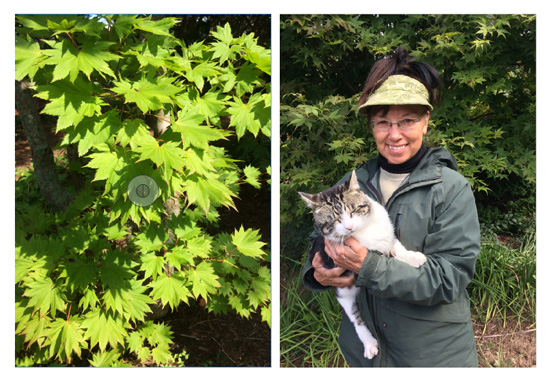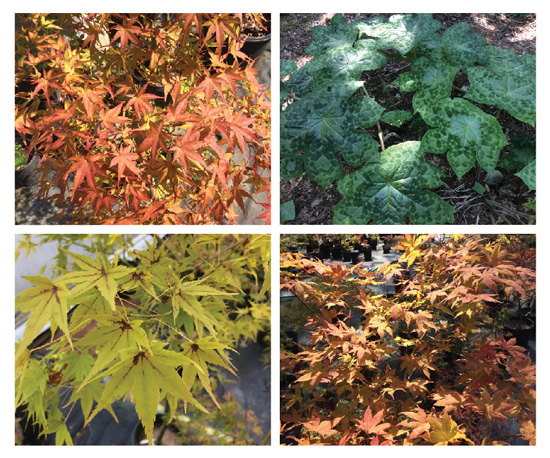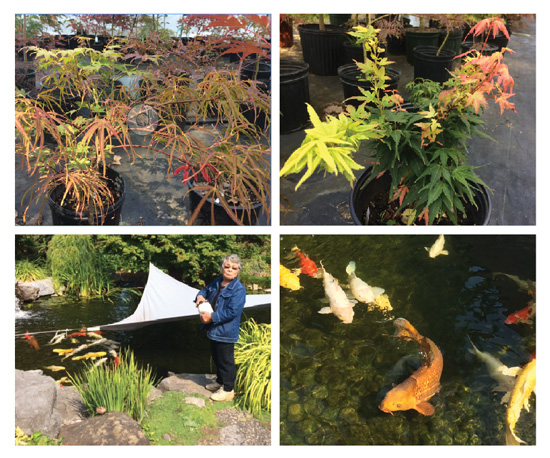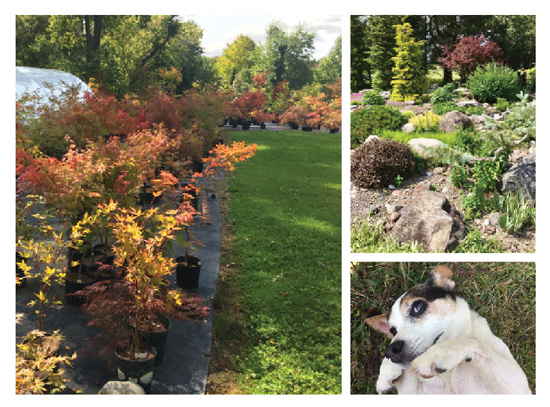Story and photos by Michelle Sutton, except where noted; plant photo descriptions by Diana Smith

RIGHT: Acer shirasawanum ‘Microphyllum’ is a very pretty understory tree with outstanding orange to red fall color. A strong tree that can reach 15 feet tall.
LEFT: Diana Smith with her cat, Bully.
Not just 750 Japanese maple plants. More than 750 Japanese maple varieties. At least, that’s what Diana Smith, proprietor of Topiary Gardens in the town of Marcellus in Onondaga County, estimates. After 700 varieties, she stopped counting. She was too busy propagating them.
Diana comes from a family of entrepreneurs with deep roots in Marcellus. Her father, Donald, started a stone and screened topsoil business in 1951 that her brothers Dave and Dan carry on. Her brother Duane helps her with her landscaping installations on weekends when he has some free time. Her sprightly 88-year-old Mom, Betty, who is originally from Japan, does most of the display garden maintenance. Diana’s sister in law helps out too. Her super-affectionate cat, Bully, chases away chipmunks and anything else that gets in his way. Her dog, Suki, provides entertainment.

RIGHT: Acer palmatum ‘Amagi Shigure’ has some of the most intense brick red colors I’ve seen in a maple. The spring colors have been described as eye-popping fuchsia, shifting to deep brick red with dark greenish black veins. Leaves that are more shaded take on a pale whitish-pink tone with vibrant green reticulation. This stunner will grow to about 6 feet high and 3 feet wide in 10 years. Description and Photo Courtesy Topiary Gardens
LEFT: Acer japonicum ‘Otaki’ is known for outstanding fall color: yellow, orange, red, and sometimes peach tones. In spring, the leaf comes out green with a silver pubescence and a red cast before becoming light green and slightly darker in the summer months. It’s a nice small Japonicum type, reaching 10 feet, with a feathery appearance. ‘Otaki’ can grow in the sun or in partial to dappled shade.
Diana worked more than 20 years for a nearby nursery before eventually embarking full-time on her own businesses in landscape installation and maintenance and propagating and selling Japanese maples and conifers. She started collecting Japanese maples in 1990, ordering from nurseries on the West Coast. At that time, a blight was devastating the southern nurseries’ Japanese maple stock. It was an opportune time to start propagating and selling maples on the East Coast since it was getting extremely costly to purchase maples from the West Coast growers, whose stock was in such high demand.
At the same time she was teaching herself how to propagate woody plants, Diana began her own landscape installation business, specializing in water features. She says, “I’d get my inspiration from walking up creeks around New York State, finding waterfalls, and taking note of how the plants, rocks, and water all relate. It gave me ideas about how to lay out gardens.” The other big source of inspiration was seeing gardens in Japan on family trips there, especially to Kyoto.

TOP RIGHT: Acer palmatum ‘Wilson’s Pink Dwarf’ is a slow-growing, upright tree that maxes out at 8 to 10 feet tall. The leaves emerge in spring like tiny shrimp on the ends of the branches before becoming a pink-green and then light green through the summer months. Fall color is yellow and orange with hints of crimson at times. It can grow in sun or partial to dappled shade.
BOTTOM RIGHT: This is Acer palmatum ‘Kawahara no midori’ in the fall. Midori means “green.” It is pale green in the spring, becoming chartreuse green in the summer, and turning clear yellow in the fall. Another ornamental feature is the green new branches. It’s an upright, vase shape, medium-sized tree that does best in the shade; it will burn in the hot afternoon sun.
TOP LEFT: ‘Spotty Dotty’ mayapple (Podophyllum) pairs well with understory Japanese maples.
BOTTOM LEFT: Acer palmatum ‘Lazy Leaf’ is a chunky upright form that matures at 10 feet tall and can grow in sun or shade. The summer foliage is medium green, and the fall color is orange and yellow.
Before long, Diana was selling maples via mail order, and in 2002 she started selling online when she was creating a large garden for a client who also designed websites. He created a site that Diana was very pleased with, and the online business took off fast. She says, “Word got around that my trees grow slower than West Coast trees, but they ‘caliper up’ faster, meaning that they are a fuller specimen at a young age, which people like. They look more like miniature trees with a nice shape as opposed to just a stick with two branches on it, which is what you can get in warmer growing climates.”
•••
In some ways, Marcellus (Zone 5a) is an unlikely place to grow Japanese maples. The winter cold and winds can be pretty fierce. What does Diana advise people in climates like hers to do?
“First, avoid planting where you’ll have southwest winds if you can,” she says. “Water new plantings really well right to the point that the ground is persistently frozen, because the more hydrated the plant is going into winter, the better it can withstand the desiccating winds. Then, wrap the plant in burlap for at least the first two winters.”

TOP RIGHT: Acer palmatum ‘Enkan’ is a strap leaf, or linearilobum, type of Japanese maple. Its spring color is dark maroon changing to bronze-red in late summer. Fall color is orange to red. It’s a small tree with an open oval habit, reaching 6 to 8 feet tall and wide. Plant it in full sun to get the best maroon color.
TOP LEFT: Acer palmatum ‘Mikawa yatsubusa’ is a dwarf maple with large, light green leaves overlaying each other on compressed stems. At 6 feet at maturity, this maple is great for rock gardens, bonsai, and patio plantings. Beautiful fall color—yellow, turning to orange. Can grow in sun or part shade in well-drained soil. Everyone’s favorite.
BOTTOM RIGHT: Diana’s mother, Betty, feeding the fish. “My mom didn’t like flowers until I started getting more and more into them. Now she’s a worse plant addict than me! I’m glad she likes it—it keeps her outside and active.”
BOTTOM LEFT: The bronze koi fish is a female—the alpha among all the koi—named “Piggie.”
The generally significant snow cover in Marcellus is a good temperature-regulating “mulch” for the roots of Diana’s Japanese maples. Unfortunately, however, winters with extreme freeze-thaw zigs and zags are hard on the trees no matter where they are sited or how well hydrated or covered they are. Diana says that the best thing you can do to mitigate against the freeze-thaw challenge is to use big boulders, rocks, stone mulch—the stone will hold and absorb heat and can help keep the trunk warm, making it less susceptible to the freeze-thaw effect. “Even Christmas lights can help,” she says. “I tell clients to wrap lights around the trunk to help keep it warm, and/or put a spotlight on the tree at night or hang a light bulb in it. All of these things can bump your tree’s microclimate up—half a hardiness zone in the country, or a full zone in the city.”
On her family land, the soil is a sandy loam pretty much perfect for growing Japanese maples because in terms of pH, they prefer a neutral to slightly acidic soil. Soil fertility is a different matter; Diana says that soil fertility can greatly affect leaf color. “If you want a dark, deeper color foliage, give the tree a richer soil,” she says, “but if you want lighter, brighter foliage, use a less nutrient-rich soil. Japanese maples don’t mind being nutrient-stressed—they’ll adapt to whatever soil you put them in—so it’s really about what color foliage you want.” Diana never fertilizes her Japanese maples in the landscape.
Japanese maple selections vary in their sun/shade preference. The one truism is that yellow-leaf and variegated Japanese maples will have the best foliage color in the shade. What about critter protection? Diana’s favorite repellent for both deer and smaller animals is Bobbex, to which she adds some peppermint oil. Pungent Bobbex has a good tackifier, so it won’t wash off immediately, and the peppermint oil irritates the animals’ noses or mouths. Her concoction repels animals for four to six weeks per application.
•••

LEFT: A handful of the more than 750 varieties Diana propagates.
TOP RIGHT: One of many display gardens at the nursery. Photo Courtesy Topiary Gardens
BOTTOM RIGHT: Diana’s beloved dog, Suki.
Because of the increasing demand for small, low-maintenance material for today’s smaller gardens, Diana has been expanding into offering dwarf evergreens. “They’re a good complimentary plant to Japanese maples,” she says. “A lot of people with small properties are realizing now that all you need is a Japanese maple, an evergreen, and a few flowers and you’re set.” She says that some evergreens will need a little more care than Japanese maples because some do prefer a more acidic soil. If you’re going to plant evergreens in clay, you’ll want to amend the soil broadly and apply acidifier at regular intervals.
Diana is also moving into propagating unusual perennials, like the spotted-leaf mayapple (Podophyllum ‘Spotty Dotty’), the compact ‘Queen Charlotte’ Japanese anemone (Anemone x hybrida) with its three-inch soft pink flowers, the ‘Margaret Wilson’ geranium (Geranium phaeum) with deeply cut, creamy-variegated foliage, the strikingly variegated ‘Loraine Sunshine’ ox-eye daisy (Heliopsis); Astilboides tabularis, a plant that has striking umbrella-like leaves, and the white flowering toad lily (Tricyrtis ‘White Towers’). She wants to try grafting tree peonies, but without the fungicide typically involved, so she is studying a technique for that.
In five years, she sees herself doing less landscaping and more work propagating a diverse variety of plant material for one- and two-gallon containers. “As I get older, I can’t dig up giant rocks and move big trees like I used to,” she says. That’s in spite of being very physically fit—Diana used to work as a personal trainer and group aerobics instructor, and, in addition to doing physical work, keeps in shape by aerobic kickboxing.
Topiary Gardens (topiary-gardens.com) is open by appointment.
Michelle Sutton (michellejudysutton.com) is a horticulturist, editor, and writer.
Views: 0





